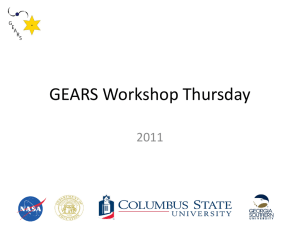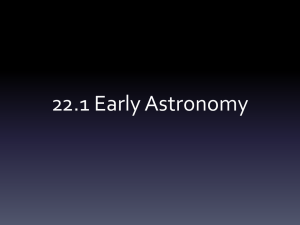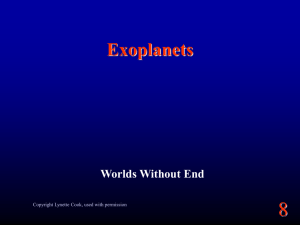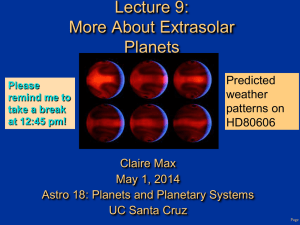Lecture17-ASTA01
advertisement
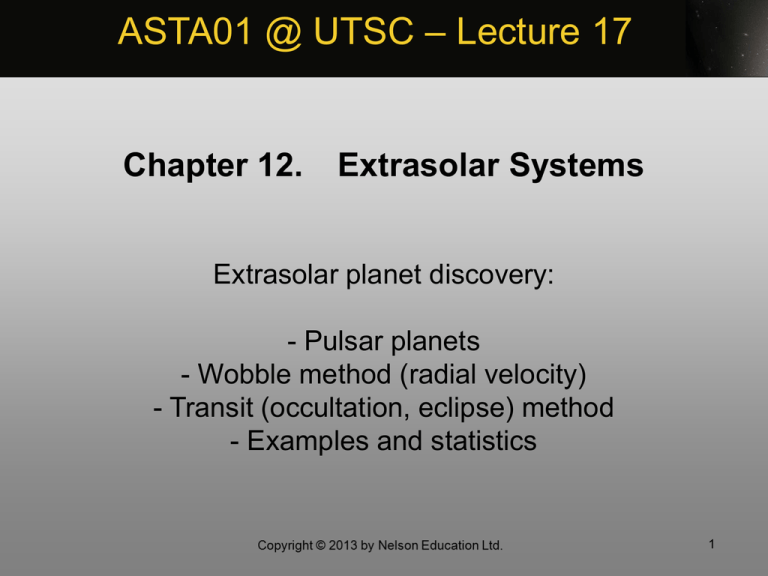
ASTA01 @ UTSC – Lecture 17 Chapter 12. Extrasolar Systems Extrasolar planet discovery: - Pulsar planets - Wobble method (radial velocity) - Transit (occultation, eclipse) method - Examples and statistics 1 HD 1415969 Observations by Hubble Space Telescope (NICMOS near-IR camera). Age ~ 5 Myr, a transitional disk Gap-opening PLANET ? So far out? Only if migrated outward R_gap~350Ad R ~ 0.1 R_gap 2 HD 14169A disk gap confirmed by new observations (HST/ACS) 3 Alpha Pisces Austrini (α PsA) Fomalhaut A disk of a bright southern star 4 5 Planets Orbiting Other Stars • Are there planets orbiting other stars? • Are there planets like Earth? • The evidence so far makes that seem likely YES • We already have found Earth-mass planets • But we don’t yet know how closely they resemble our planet 6 Extrasolar Planets • A planet orbiting another star is called an extrasolar planet or an exoplanet • Such a planet would be is usually quite faint and difficult to detect close to the glare of its star. • However, there are ways to find these planets. • To see how, all you have to do is imagine walking a dog. 7 Extrasolar Planets • Think of someone walking a poorly trained dog on a leash. • The dog runs around pulling on the leash. • Even if it were an invisible dog, you could plot its path by watching how its owner was jerked back and forth around the Center of Mass Extrasolar Planets • In the same way, astronomers can detect a planet orbiting another star – by watching how the star moves as the planet tugs on it. Extrasolar Planets How the star moves is revealed by either: • It’s sinusoidal motion on a sky (astrometric detection), or • How its light changes frequency due to te Doppler effect (radial velocity detection), or • If it sends pulses as a pulsar, then by the time delay of pulse arrival times • When the star approaches us, we see lower frequency of pulses, or of electromagnetic waves Extrasolar Planets: discovery in 1992 • [In 1988, Canadian astronomers Bruce Campbell, G.A.H. Walker, and S. Yang discovered an extrasolar planet orbiting a binary star system, but their discovery was not confirmed until 2002.] • The first 3 confirmed extrasolar planets were discovered around a pulsar by the Polish astronomer Alex Wolszczan (b. 1946) [read: Volsh-chan] in 1992 • He studied & worked in Toruń, the city of Copernicus, but discovered planets with the Arecibo radio telescope in Puerto Rico, with his coworker D. Frail. 11 Extrasolar Planets: discovery • Pulsar’s name is PSR 1257+12 • It formed in a supernova explosion and has 3 ms period of rotation • 4 Planets have masses: 0.02, 4.3, 3.9, 0.0004 ME distances 0.19, 0.36, 0.46, 2.6 AU 12 Chart of three PSR 1257+12 planets & inner solar system planets 13 Extrasolar Planets: 51 Peg • The first planet orbiting a sunlike star was discovered in 1995 around the star 51 Pegasi. • As the planet circles the star, the star wobbles slightly. • The very small motions of the star are detectable as Doppler shifts in the star’s spectrum. • This is the same technique used to study spectroscopic binary stars. Michel Mayor (b.1942), Switzerland Extrasolar Planets: 51 Peg • From the motion of the star and estimates of the star’s mass, astronomers can deduce that the 51 Peg b planet has half the mass of Jupiter and orbits only 0.05 AU from the star ( << sun-Mercury distance) • Half the mass of Jupiter amounts to 160 Earth masses. A large planet, larger than Saturn. 15 16 Extrasolar Planets • Astronomers were not surprised by the announcement that a planet orbits 51 Peg • For years, they had assumed that many stars had planets • Nevertheless, some of them (Canadian David Grey) greeted the discovery with skepticism • That skepticism led to careful tests of the data and further observations that confirmed the discovery 17 Extrasolar Planets • Over 500 planets have been discovered in this way – including at least three planets orbiting the star Upsilon Andromedae, and five orbiting 55 Cancri – true planetary system. • More than 40 such multiple-planet systems have been found. Extrasolar Planets • Another way to search for planets is to look for changes in the brightness of a star when the orbiting planet crosses in front of or behind it. • The decrease in light is very small, ~Rpl 2 • Astronomers have used this technique to detect a few 1000s of planets as they crossed in front of their stars. 19 Extrasolar Planets • The Spitzer Infrared Space Telescope has detected two planets when they passed behind their stars. • These planets are hot and emit significant infrared radiation. • As they orbit their parent stars, astronomers detect variation in the amount of infrared from the system. Measurements reveal that they have Jupiter-like diameters as well as masses. So, astronomers conclude they have Jovian densities and compositions. 20 Extrasolar Planets 21 Extrasolar Planets 2012 • Planets known so far 22 Extrasolar Systems: the first images, HR 8799 • Actually getting an image of a planet orbiting another star is about as easy as photographing a bug crawling on the bulb of a searchlight miles away. • Planets are small and dim and get lost in the glare of the stars they orbit. 23 Beta Pictoris giant planet 24 Extrasolar Planets • In 2007, astronomers discovered what could be low-mass Earth-like planets orbiting a red dwarf star named Gliese 581 located a mere 20.3 light-years away. • In 2011, a team of scientists in France confirmed that at least one of the planets could have an atmosphere and oceans, and support Earth-like life. Extrasolar Planets: Gliese 581 Extrasolar Planets: Kepler satellite observatory • The main aim of the Kepler mission is to find Earth like planets in habitable zones around other stars. • For the first time in the history of our search for the worlds that resemble our own, we have the technical capabilities to see small rocky planets. 27 Extrasolar Planets • The sizes of the newly discovered planets range from 1.5 times the size of Earth to large Jupiter-sized worlds. • Spectral analyses of trails of smaller planets show traces of silicates (building blocks of rocks), ice, and water. • The Spitzer infrared telescope, which prior to the Kepler mission discovered numerous large, hot, Jupiter-like planets around their stars, is being used to confirm the Kepler telescope findings. 28 Extrasolar Planets: Kepler 11 system • In the few first months of the mission more than 1200 planet candidates were detected, many of them multiple planetary systems. • One such system is Kepler 11, six tightly packed planets located 2000 light-years from Earth; planets range from 2.5 to 4.5 times Earth’s size. 29 Kepler 11 system 30 2011 31 Extrasolar Planets • Some unusual arrangements of planets have been discovered by the Kepler mission. • Notably, astronomers were shocked to see two planets sharing an orbit – the planets were arranged in the exact angular distance that theoretically allows for such an arrangement. • Seeing such variety of possibilities allows us to explore and test many hypotheses about our own solar system’s origin and formation. 32 Extrasolar Planets • The discovery of extrasolar planets gives astronomers added confidence in the solar nebula theory. • The theory predicts that planets are common. • Astronomers are finding them orbiting many stars. 33


